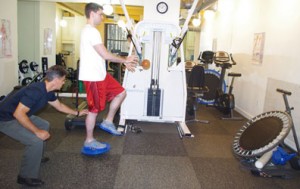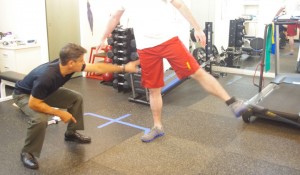The tendons that are involved in De Quervain’s tenosynovitis are the abductor pollicis longus and the extensor pollicis brevis, which pass through a tunnel near the thumb side of the wrist. Irritation of the tendons and the tunnel can cause swelling, pain and scar tissue. This can limit movement in the thumb and wrist.
Conservative treatment may include resting the tendons in a thumb splint, ultrasound and/or electrical stimulation to heal tissues and improve circulation, cold therapy to decrease pain and swelling, and techniques to reduce scar tissue. Your hand therapist can teach you exercises that strengthen muscles and allow the tendons to glide normally. The therapist can also provide education about changing daily activities to prevent recurrences.
If conservative treatment is not effective, your doctor may inject cortisone to the site of irritation, which usually reduces pain and swelling. In cases of severe or chronic swelling and pain that limits function in the thumb, surgery may be required to release the tunnel covering the tendons. Hand therapy following surgery will focus on exercises of the thumb and wrist, scar management, muscle strengthening and proper body mechanics. Prompt treatment results in quicker improvement and better long-term results.



 Yoga began more than four thousand years ago, but it has become increasingly popular over the last several years. Hatha yoga is the physical component of yoga, and it involves performing a series of poses while controlling your breathing. Yoga has many benefits, including increased flexibility, strength, balance and endurance. Many say yoga helps to decrease stress and anxiety as well. However, if you are new to yoga, you may get injured if you force your body into poses it is not ready for. Maintaining proper technique and avoiding simple mistakes can help you perform yoga injury free.
Yoga began more than four thousand years ago, but it has become increasingly popular over the last several years. Hatha yoga is the physical component of yoga, and it involves performing a series of poses while controlling your breathing. Yoga has many benefits, including increased flexibility, strength, balance and endurance. Many say yoga helps to decrease stress and anxiety as well. However, if you are new to yoga, you may get injured if you force your body into poses it is not ready for. Maintaining proper technique and avoiding simple mistakes can help you perform yoga injury free.
 Protect your knees. Do not lock your knees when standing. When kneeling, place a cushion under your knees to avoid excess pressure on the knees.
Protect your knees. Do not lock your knees when standing. When kneeling, place a cushion under your knees to avoid excess pressure on the knees.